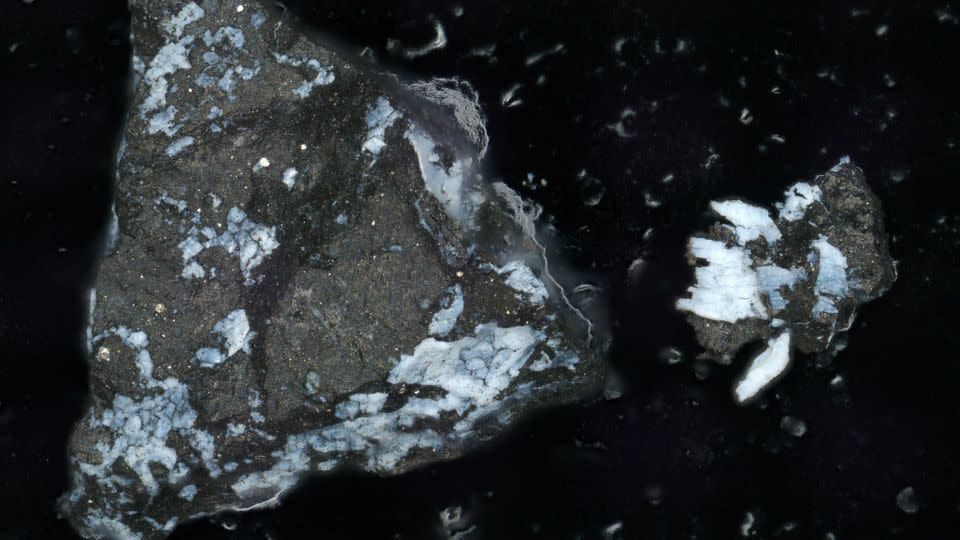Sign up for CNN’s Wonder Theory science newsletter. Explore the universe with news about fascinating discoveries, scientific advancements and more.
Early analysis of a sample collected from the asteroid Bennu suggests the space rock has an unexpectedly water-rich past and may even have broken up from an ancient ocean world.
NASA’s OSIRIS-REx mission collected a pristine sample weighing 4.3 ounces (121.6 grams) from the near-Earth asteroid in 2020 and brought it back to Earth last September.
Since then, scientists have been analyzing the asteroid’s rocks and dust to see what secrets it might hold about its composition and whether it could bring elements necessary for life to Earth. Asteroids are also of interest to scientists because they are remnants of the formation of the solar system.
Initial examination of some samples shared in October suggested that the asteroid contained large amounts of carbon.
During the new analysis of the sample, the team discovered that Bennu’s dust is rich in carbon, nitrogen and organic compounds, all of which helped form the solar system. These components are also essential for life as we understand it and may help scientists better understand how Earth-like planets evolve.
A study detailing the findings was published Wednesday in the journal Meteoritics & Planetary Science.
“OSIRIS-REx gave us exactly what we were hoping for: a large, intact asteroid sample rich in nitrogen and carbon from a previously wet world,” study co-author Jason Dworkin, OSIRIS-REx project scientist at NASA’s Goddard Space Flight Center in Greenbelt, Maryland, said in a statement.
Elements for life
The biggest surprise was the presence of magnesium-sodium phosphate in the sample, which OSIRIS-REx, or the Origins, Spectral Interpretation, Resource Identification, and Security—Regolith Explorer mission initially failed to detect via remote sensing while orbiting Bennu.
Magnesium-sodium phosphate is a water-soluble compound that serves as a component of biochemistry for life.

The asteroid may have broken away from a small, primitive ocean world that no longer exists in our solar system, the researchers said.
The asteroid’s sample is largely composed of clay minerals, including serpentine, making it very similar to rocks found at Earth’s mid-ocean ridges, which are where material from the mantle, the layer beneath Earth’s surface crust, meets water.
A similar phosphate was found in a sample from the Ryugu asteroid collected by the Japan Aerospace Exploration Agency’s Hayabusa2 mission and sent to Earth in December 2020. However, the compound in the Bennu sample is purer and has larger grains.
“The presence and composition of phosphates, along with other elements and compounds on Bennu, suggest a wet past for the asteroid,” said Dante Lauretta, OSIRIS-REx principal investigator and a professor emeritus at the University of Arizona, in a statement from Tucson. “Bennu could potentially have once been part of a wetter world. However, this hypothesis requires further investigation.”
Cosmic time capsules
Rocks collected from Bennu are a time capsule of the early Solar System, dating back more than 4.5 billion years.


“The sample we returned is currently the largest deposit of intact asteroid material on Earth,” Lauretta said.
Astronomers believe that space rocks such as asteroids and comets may have served as ancient messengers in our solar system.
“This means asteroids like this may have played an important role in transporting water and the building blocks of life to Earth,” said study author Nick Timms, an OSIRIS-REx Sample Analysis team member and associate professor in Curtin University’s School of Earth and Planetary Science, in a statement.
If these smaller rocky masses had carried water, minerals and other elements and collided with the Earth as it was forming billions of years ago, they could have paved the way for life on our planet.
“These findings highlight the importance of collecting and studying material from asteroids like Bennu, especially low-density material that will typically burn up when it enters Earth’s atmosphere,” Lauretta said. “This material holds the key to unraveling the complex processes of Solar System formation and the prebiotic chemistry that may have contributed to the emergence of life on Earth.”
The wealth of material collected from the asteroid means more labs around the world will be getting their own pieces of the sample to study.
“The Bennu samples are seductively beautiful extraterrestrial rocks,” said co-lead study author Harold Connolly Jr., OSIRIS-REx mission sample scientist and chair of the geology department at Rowan University’s School of Earth and Environment in Glassboro, New Jersey. in a statement. “Each week, analyzes by the OSIRIS-REx Sample Analysis Team provide new and sometimes surprising findings that help establish important constraints on the origin and evolution of Earth-like planets.”
For more CNN news and newsletters, create an account at CNN.com